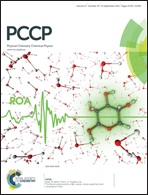Tunable conduction type of solution-processed germanium nanoparticle based field effect transistors and their inverter integration†
Abstract
In this work we demonstrate the fabrication of germanium nanoparticle (NP) based electronics. The whole process chain from the nanoparticle production up to the point of inverter integration is covered. Ge NPs with a mean diameter of 33 nm and a geometric standard deviation of 1.19 are synthesized in the gas phase by thermal decomposition of GeH4 precursor in a seeded growth process. Dispersions of these particles in ethanol are employed to fabricate thin particulate films (60 to 120 nm in thickness) on substrates with a pre-patterned interdigitated aluminum electrode structure. The effect of temperature treatment, polymethyl methacrylate encapsulation and alumina coating by plasma-assisted atomic layer deposition (employing various temperatures) on the performance of these layers as thin film transistors (TFTs) is investigated. This coating combined with thermal annealing delivers ambipolar TFTs which show an Ion/Ioff ratio in the range of 102. We report fabrication of n-type, p-type or ambipolar Ge NP TFTs at maximum temperatures of 450 °C. For the first time, a circuit using two ambipolar TFTs is demonstrated to function as a NOT gate with an inverter gain of up to 4 which can be operated at room temperature in ambient air.


 Please wait while we load your content...
Please wait while we load your content...